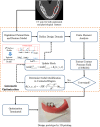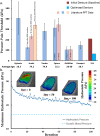Shape Optimization for Additive Manufacturing of Removable Partial Dentures--A New Paradigm for Prosthetic CAD/CAM
- PMID: 26161878
- PMCID: PMC4498620
- DOI: 10.1371/journal.pone.0132552
Shape Optimization for Additive Manufacturing of Removable Partial Dentures--A New Paradigm for Prosthetic CAD/CAM
Abstract
With ever-growing aging population and demand for denture treatments, pressure-induced mucosa lesion and residual ridge resorption remain main sources of clinical complications. Conventional denture design and fabrication are challenged for its labor and experience intensity, urgently necessitating an automatic procedure. This study aims to develop a fully automatic procedure enabling shape optimization and additive manufacturing of removable partial dentures (RPD), to maximize the uniformity of contact pressure distribution on the mucosa, thereby reducing associated clinical complications. A 3D heterogeneous finite element (FE) model was constructed from CT scan, and the critical tissue of mucosa was modeled as a hyperelastic material from in vivo clinical data. A contact shape optimization algorithm was developed based on the bi-directional evolutionary structural optimization (BESO) technique. Both initial and optimized dentures were prototyped by 3D printing technology and evaluated with in vitro tests. Through the optimization, the peak contact pressure was reduced by 70%, and the uniformity was improved by 63%. In vitro tests verified the effectiveness of this procedure, and the hydrostatic pressure induced in the mucosa is well below clinical pressure-pain thresholds (PPT), potentially lessening risk of residual ridge resorption. This proposed computational optimization and additive fabrication procedure provides a novel method for fast denture design and adjustment at low cost, with quantitative guidelines and computer aided design and manufacturing (CAD/CAM) for a specific patient. The integration of digitalized modeling, computational optimization, and free-form fabrication enables more efficient clinical adaptation. The customized optimal denture design is expected to minimize pain/discomfort and potentially reduce long-term residual ridge resorption.
Conflict of interest statement
Figures






References
-
- Kydd WL, Daly CH, Nansen D. Variation in the response to mechanical stress of human soft tissues as related to age. J Prosthet Dent 1974; 32: 493–500. - PubMed
-
- Mori S, Sato T, Hara T, Nakashima K, Minagi S. Effect of continuous pressure on histopathological changes in denture-supporting tissues. J Oral Rehabil 1997; 24: 37–46. - PubMed
Publication types
MeSH terms
LinkOut - more resources
Full Text Sources
Other Literature Sources
Miscellaneous

